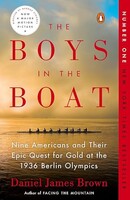Book notes: The Boys in the Boat
Jan 03, 2024
By Daniel James Brown.
The Boys in the Boat is currently on the nytimes bestseller list for 147 weeks and #1 in paperback fiction. My wife has recommended this book for many years (it was published in 2013), and I bumped it up the list now that the movie is coming out.
The story follows the University of Washington rowing team over 3 seasons, their rivalry with The University of California Berkeley, racing against East Coast universities at Poughkeepsie, and ending with a gold medal performance at the 1936 Olympics.
I’d put the “word count feel” of the book at a “medium”… 370 pages but a lot of words on each page, with about a dozen pictures. But the story is gripping even though you know the ending. Halfway through each race you’re not really sure if they will win, especially against those cheating host officials running the race at Grünau. The writing style keeps you going. I was struck at the amount of detail in each moment. E.g. during the race a train went by before the start, billowing smoke. The water was a certain color, the wind conditions, etc. The author has a note at the end about the research to get these details: there were many contemporaneous sources: some of the rowers and coaches kept journals, newspaper articles. A couple of the members were still alive, and many stories were told down through the generations.
Most of the character development is around one of the rowers: Joe Rantz. His mother dies when he is young and there is a heartbreaking moment where his family abandons him when he is 15 years old. They are living in Sequim, WA, during the depression and the father, step-mother, and 3 step-siblings load up in the car and leave him in a half-finished house with dad saying “You have to find your own happiness in life”. Joe has trust problems and doesn’t row his best until the rowing team develops full trust with each other.
There are many historical tidbits given along the way that added interest and context. Seabiscuit’s trainer alters the horse’s diet based on the UW rowing diet. Joe helps build the Grand Coulee dam in central Washington. During train rides the team sees the effects of the Dust Bowl on the United States. Times were tough for everyone because of the Great Depression. There were many details about Nazi Germany… Joeseph Goebbels and Leni Riefenstahl on propaganda and filming the Nuremberg Rally and Olympics.
I always enjoy a good team building story. The coaches Al Ulbrickson and Tom Bowles are building a rowing program at UW. They recruit local athletes, put them through brutal training schedules, and figure out how to have the right teamwork chemistry in their boats. There is an emotional moment at the end of the book about the “surviving member” from that olympic team, the Husky Clipper that hangs today in UW’s new Shellhouse that continues to inspire a new generation of UW rowers.
Rowing was much more popular then than it is now, with big rowing events drawing many tens of thousands of spectators. But rowing is still fairly popular in Seattle. I routinely see rowing teams on Green Lake, Lake Washington, and the Cut.
This book is a must read. Especially if you live in the Seattle area, because of the many local historical references.